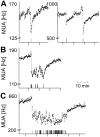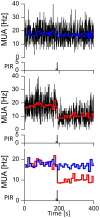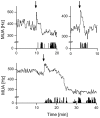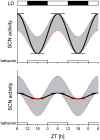Amplitude of the SCN clock enhanced by the behavioral activity rhythm
- PMID: 22761873
- PMCID: PMC3386260
- DOI: 10.1371/journal.pone.0039693
Amplitude of the SCN clock enhanced by the behavioral activity rhythm
Abstract
Circadian rhythms are regulated by the suprachiasmatic nucleus (SCN), a small structure at the base of the hypothalamus. While light effects on the SCN are well established, little is known of behavioral effects. This study elucidates direct modulating action of behavioral activity on the SCN by use of in vivo electrophysiology recordings, assessments of general locomotor behavior, and video-tracking of mice. The results show suppression of SCN neuronal activity by spontaneous behavior, the magnitude being dependent on the intensity, duration and type of behavioral activity. The suppression was moderate (32% of circadian amplitude) for low-intensity behavior and considerable (59%) for locomotor activity. Mild manipulation of the animals had reversed effects on the SCN indicating that different mechanisms are involved in the regulatory effect of spontaneous versus induced activity. The results indicate that exercise at the proper time of the cycle can boost the amplitude of the rhythm of the SCN clock itself. This has potentially beneficial effects for other rhythmic functions that are under the control of the SCN.
Conflict of interest statement
Figures







Similar articles
-
In vivo monitoring of multi-unit neural activity in the suprachiasmatic nucleus reveals robust circadian rhythms in Period1⁻/⁻ mice.PLoS One. 2013 May 22;8(5):e64333. doi: 10.1371/journal.pone.0064333. Print 2013. PLoS One. 2013. PMID: 23717599 Free PMC article.
-
Pet-1 deficiency alters the circadian clock and its temporal organization of behavior.PLoS One. 2014 May 15;9(5):e97412. doi: 10.1371/journal.pone.0097412. eCollection 2014. PLoS One. 2014. PMID: 24831114 Free PMC article.
-
Connexin30 and Connexin43 show a time-of-day dependent expression in the mouse suprachiasmatic nucleus and modulate rhythmic locomotor activity in the context of chronodisruption.Cell Commun Signal. 2019 Jun 11;17(1):61. doi: 10.1186/s12964-019-0370-2. Cell Commun Signal. 2019. PMID: 31186021 Free PMC article.
-
BK channels regulate spontaneous action potential rhythmicity in the suprachiasmatic nucleus.PLoS One. 2008;3(12):e3884. doi: 10.1371/journal.pone.0003884. Epub 2008 Dec 8. PLoS One. 2008. PMID: 19060951 Free PMC article.
-
[Mechanisms of structural plasticity associated with photic synchronization of the circadian clock within the suprachiasmatic nucleus].J Soc Biol. 2009;203(1):49-63. doi: 10.1051/jbio:2009004. Epub 2009 Apr 10. J Soc Biol. 2009. PMID: 19358811 Review. French.
Cited by
-
Daily electrical activity in the master circadian clock of a diurnal mammal.Elife. 2021 Nov 30;10:e68179. doi: 10.7554/eLife.68179. Elife. 2021. PMID: 34845984 Free PMC article.
-
Adult cyclical vomiting syndrome: a disorder of allostatic regulation?Exp Brain Res. 2014 Aug;232(8):2541-7. doi: 10.1007/s00221-014-3939-4. Epub 2014 Apr 16. Exp Brain Res. 2014. PMID: 24736863 Review.
-
The Role of the Melatoninergic System in Circadian and Seasonal Rhythms-Insights From Different Mouse Strains.Front Physiol. 2022 Apr 12;13:883637. doi: 10.3389/fphys.2022.883637. eCollection 2022. Front Physiol. 2022. PMID: 35492605 Free PMC article. Review.
-
From clock to functional pacemaker.Eur J Neurosci. 2020 Jan;51(1):482-493. doi: 10.1111/ejn.14388. Epub 2019 May 2. Eur J Neurosci. 2020. PMID: 30793396 Free PMC article. Review.
-
Circadian regulation of mouse suprachiasmatic nuclei neuronal states shapes responses to orexin.Eur J Neurosci. 2017 Mar;45(5):723-732. doi: 10.1111/ejn.13506. Epub 2017 Jan 9. Eur J Neurosci. 2017. PMID: 27987373 Free PMC article.
References
Publication types
MeSH terms
LinkOut - more resources
Full Text Sources

